Spatiotemporal Characteristics of Tropical Cyclone Precipitation in Guangdong Province, China, from 1961 to 2020
Abstract
:1. Introduction
2. Materials and Methods
2.1. Study Area and Data
2.2. Methods
2.2.1. Selection of TCs Affecting Guangdong
- (1)
- Separation of independent rainbands
- (2)
- Identification of the TC’s rainbands.
2.2.2. Spatiotemporal Analysis to Explore the Overall Characteristics of TC Precipitation
- (1)
- Trend analysis
- (2)
- EOF analysis
2.2.3. Cluster Methods for Exploring the Differences in TC Precipitation at the Different Stations
- (1)
- Spatial clustering considering attributes
- (2)
- Time-series clustering
3. Results
3.1. Spatiotemporal Characteristics of TC Precipitation in Guangdong Province
3.1.1. Temporal Change Characteristics
3.1.2. Spatial Distribution Characteristics
3.1.3. EOF Analysis of TC Precipitation
3.2. Comparison of TC Precipitation at Different Stations
3.2.1. Spatial Clustering of TC Precipitation at Different Stations
3.2.2. Time-Series Clustering of TC Precipitation at the Various Stations
4. Discussion
5. Conclusions
- In the past 60 years, the TC and TC precipitation affecting Guangdong Province mainly occurred in the SRS. The number of TCs in the FRS, SRS, and NRS, and for the WY, along with the TC precipitation for the SRS and NRS and for the WY, all showed a decreasing trend. Conversely, the levels of TC precipitation in the FRS showed an increasing trend. The inter-annual fluctuations of TC frequency and TC precipitation were apparent, exhibiting a quasi-periodic variation.
- The TC precipitation values in the FRS, SRS, and NRS and those for the WY all showed a gradual decreasing trend from the coastal to the inland areas. Meanwhile, the western coastal areas received more TC precipitation than the eastern coastal areas in certain periods of the SRS and NRS and for the WY.
- The spatial variations in TC precipitation in Guangdong in the four periods over the last six decades were quite similar, with three primary spatial modes and six patterns. In the case of the first mode, TC precipitation in the whole province was either consistently more than normal or consistently less than normal; in the second mode, there was either more TC precipitation in eastern Guangdong and less in western Guangdong, or less TC precipitation in eastern Guangdong and more in western Guangdong; in the third mode, the TC precipitation was either more than normal in the central region of Guangdong and there was less precipitation in the eastern and western regions of Guangdong, or there was less precipitation in the central region of Guangdong and more precipitation in the eastern and western regions. Among these patterns, the spatial distribution pattern of TC precipitation being less than normal over the whole province is the most common.
- The clustering analysis results show that stations recording more precipitation and large inter-annual fluctuations are often distributed in coastal areas, while stations recording less precipitation and small inter-annual fluctuations are distributed in inland areas. However, the primary areas influenced by TCs are not the same in the different periods. In the case of the FRS, TC precipitation was relatively higher in the southern coastal areas of the Pearl River Delta. In the case of the NRS, the western and eastern coastal areas of Guangdong had more TC precipitation. As for the SRS and the WY, there was little difference in TC precipitation in the coastal areas.
Author Contributions
Funding
Institutional Review Board Statement
Informed Consent Statement
Data Availability Statement
Conflicts of Interest
References
- Wang, D.; Dong, Z.; Ling, Z.; Jiang, F.; Zhu, S.; Chen, J. Spatiotemporal variability of extreme precipitation at different time scales and quantitative analysis of associated driving teleconnection factors: Insights from Taihu Basin, China. Ecol. Indic 2022, 142, 109287. [Google Scholar] [CrossRef]
- Zhao, D.; Xu, H.; Yu, Y.; Chen, L. Identification of synoptic patterns for extreme rainfall events associated with landfalling typhoons in China during 1960–2020. Adv. Clim. Chang. Res. 2022, 13, 651–665. [Google Scholar] [CrossRef]
- Cheng, Z.; Chen, L.; Liu, Y.; Peng, T. The temporal and spatial distribution characteristics of tropical cyclone precipitation in China from 1960 to 2003. J. Appl. Meteorol. 2007, 4, 427–434. [Google Scholar]
- Chen, L.; Meng, Z.; Cong, C. Review of research on typhoon rainstorm falling area. J. Mar. Meteorol. 2017, 37, 1–7. [Google Scholar]
- Qi, Q.; Jiang, B.; Ma, W.; Marley, G. Trend Analysis and Spatial Distribution of Meteorological Disaster Losses in China. Atmosphere 2022, 13, 208. [Google Scholar] [CrossRef]
- Ying, M.; Yang, Y.; Chen, B.; Zhang, W. Climate change characteristics of tropical cyclones affecting China in recent 50 years. Geoscience 2011, 41, 1352–1364. [Google Scholar]
- Cheng, Z.; Chen, L.; Xu, X.; Peng, T. Typhoon rainstorm in China in recent 10 years. Weather 2005, 12, 3–9. [Google Scholar]
- Chalise, D.R.; Aiyyer, A.; Sankarasubramanian, A. Tropical Cyclones’ Contribution to Seasonal Precipitation and Streamflow over the Southeastern and Southcentral United States. Geophys. Res. Lett. 2021, 4, e2021GL094738. [Google Scholar] [CrossRef]
- Zhu, Q.H. Statistical Research on Characteristics of Tropical Cyclone Precipitation in Southeast China. Master’s Thesis, Nanjing University of Information Science & Technology, Nanjing, China, May 2022. [Google Scholar]
- Chang, G.; Hasegawa, A. Tropical Cyclone and Heavy Precipitation over the Western North Pacific in Present and Doubled CO2 Climates Simulated by the CCSR/NIES/FRCGC T106 AGCM. Environ. Sci. 2005, 1, 145–148. [Google Scholar]
- Englehart, P.; Douglas, A. The role of Eastern North Pacific tropical storms in the rainfall climatology of Western Mexico. Int. J. Climatol. 2001, 21, 1357–1370. [Google Scholar] [CrossRef]
- Wu, S.; Guo, D.; Yang, J. Climatic Characteristics of Tropical Cyclone Precipitation in Hainan. Acta Meteorol. Sin. 2007, 3, 307–311. [Google Scholar]
- Ren, F.; Gleason, B.; Easterling, D. A numerical method for identifying tropical cyclone precipitation. J. Trop. Meteorol. 2001, 3, 308–313. [Google Scholar]
- Ren, F.; Wang, Y.; Wang, X.; Li, W. Estimating tropical cyclone precipitation from station observations. Adv. Atmos. Sci. 2007, 24, 700–711. [Google Scholar] [CrossRef]
- Ying, M.; Chen, B.; Wu, G. Climate trends in tropical cyclone-induced wind and precipitation over mainland China. Geophys. Res. Lett. 2011, 38. [Google Scholar] [CrossRef]
- Zhang, J.; Wu, L.; Ren, F.; Cui, X. Changes in Tropical Cyclone Rainfall in China. J. Meteorol. Soc. Jpn. Ser. II 2013, 91, 585–595. [Google Scholar] [CrossRef]
- Liu, T.; Wu, L.; Zhang, J.; Ren, F. Trend analysis of tropical cyclone precipitation affecting China from July to September during 1965–2010. Acta Meteorol. Sin. 2013, 71, 63–75. [Google Scholar]
- Li, R.C.Y.; Zhou, W. Interdecadal Changes in Summertime Tropical Cyclone Precipitation over Southeast China during 1960–2009. J. Clim. 2015, 28, 1494–1509. [Google Scholar] [CrossRef]
- Jiang, X.; Ren, F.; Li, Y.; Qiu, W.; Ma, Z.; Cai, Q. Characteristics and Preliminary Causes of Tropical Cyclone Extreme Rainfall Events over Hainan Island. Adv. Atmos. Sci. 2018, 35, 580–591. [Google Scholar] [CrossRef]
- Li, R.C.Y.; Zhou, W.; Lee, T.C. Climatological Characteristics and Observed Trends of Tropical Cyclone–Induced Rainfall and Their Influences on Long-Term Rainfall Variations in Hong Kong. Mon. Weather Rev. 2015, 143, 2192–2206. [Google Scholar] [CrossRef]
- Bai, L.; Wan, R.; Guo, R.; Ying, M.; Jin, R. Climate trends in tropical cyclone-induced precipitation and wind over Shanghai. Trop. Cyclone Res. Rev. 2022, 11, 219–224. [Google Scholar] [CrossRef]
- Luo, X.; Yao, C.; Xiao, Z.; Zhang, K. Climatic change characteristics and causes of tropical cyclone precipitation over South China in the past 60 years. Ocean Forecast 2020, 37, 76–85. [Google Scholar]
- Li, S.; Cheng, Z.; Gong, Y. Spatio-temporal distribution characteristics and return period estimation of tropical cyclone precipitation in Guangdong Province. Guangdong Meteorol. 2020, 42, 1–5. [Google Scholar]
- Wang, J.; Jiang, Y.; Cui, X.; Shen, X.; Ren, F. Statistical analysis of refined observations of precipitation from landfalling tropical cyclones in Zhejiang and Fujian, 1956–2012. Atmos. Sci. 2018, 42, 16–32. [Google Scholar]
- Zheng, L.; Shen, Y.; Feng, T.; Yao, M. Characteristics of precipitation distribution of landfalling typhoons in East China. Drought Meteorol. 2022, 40, 424–435. [Google Scholar]
- Jain, A.K.; Murty, M.N.; Flynn, P.J. Data clustering: A review. Acm. Comput. Surv. 1999, 31, 264–323. [Google Scholar] [CrossRef]
- Zhang, S.; Zheng, Y.; Liu, C.; Huang, Z.; Weng, H.; Xu, J.; Tu, S. Climatology of Different Classifications of Tropical Cyclones Landfalling in Guangdong Province of China during 1951–2020. Atmosphere 2022, 13, 1306. [Google Scholar] [CrossRef]
- Xiao, Z.; Yao, C. Thermal and Dynamical Characteristics of Landfalling Severe Typhoons in South China against Different Monsoon Backgrounds. Atmosphere 2023, 14, 338. [Google Scholar] [CrossRef]
- Ying, M.; Zhang, W.; Yu, H.; Lu, X.; Feng, J.; Fan, Y.; Zhu, Y.; Chen, D. An Overview of the China Meteorological Administration Tropical Cyclone Database. J. Atmos. Ocean. Tech. 2014, 31, 287–301. [Google Scholar] [CrossRef]
- Liu, S.; Cui, X. Diagnostic Analysis of Rate and Efficiency of Torrential Rainfall Associated with Bilis (2006). Chin. J. Atmos. Sci. 2018, 42, 192. [Google Scholar]
- Lu, X.; Yu, H.; Ying, M.; Zhao, B.; Zhang, S.; Lin, L.; Bai, L.; Wan, R. Western North Pacific Tropical Cyclone Database Created by the China Meteorological Administration. Adv. Atmos. Sci. 2021, 38, 690–699. [Google Scholar] [CrossRef]
- Pei, Q.; Zhang, D.D.; Lee, H.F.; Li, G. Climate Change and Macro-Economic Cycles in Pre-Industrial Europe. PLoS ONE 2014, 9, e88155. [Google Scholar] [CrossRef] [PubMed]
- Wang, X.; Wahiduzzaman, M.; Yeasmin, A. A Kernel Density Estimation Approach and Statistical Generalized Additive Model of Western North Pacific Typhoon Activities. Atmosphere 2022, 13, 1128. [Google Scholar] [CrossRef]
- Zhang, Y.; Li, Y.; Li, D.; Shang, K.; Zheng, F. Spatial distribution characteristics and circulation patterns of summer extreme high temperature in eastern China. Plateau Meteorol. 2016, 35, 469–483. [Google Scholar]
- Yang, W.; Xu, M.; Zhou, S.; Luo, L. Temporal and spatial variation of extreme heavy rainfall events and circulation anomaly in June-July in the Yangtze-Huaihe River Basin. Plateau Meteorol. 2017, 36, 718–735. [Google Scholar]
- Shen, H.; Chen, L.; Hu, B.; Qiao, S.; Zhang, T. The main spatial pattern and circulation characteristics of summer precipitation in central Northwest China. Plateau Meteorol. 2017, 36, 455–467. [Google Scholar]
- North, G.R.; Bell, T.L.; Cahalan, R.F.; Moeng, F.J. Sampling Errors in the Estimation of Empirical Orthogonal Functions. Mon. Weather Rev. 1982, 110, 699–706. [Google Scholar] [CrossRef]
- Zhou, Y.; Wu, T. Composite analysis of precipitation intensity and distribution characteristics of western track landfall typhoons over China under strong and weak monsoon conditions. Atmos. Res. 2019, 225, 131–143. [Google Scholar] [CrossRef]
- Amin, R.W.; Kocak, S.; Sevil, H.E.; Peterson, G.P.; Hamilton, J.T.; Rivera, B.; Barraco, T. A spatio-temporal cluster analysis of structurally deficient bridges in the contiguous USA. Dev. Built Environ. 2020, 4, 100034. [Google Scholar] [CrossRef]
- Kar, A.K.; Lohani, A.K.; Goel, N.K.; Roy, G.P. Rain gauge network design for flood forecasting using multi-criteria decision analysis and clustering techniques in lower Mahanadi river basin, India. J. Hydrol. Reg. Stud. 2015, 4, 313–332. [Google Scholar] [CrossRef]
- Wang, H.; Wang, J. An improved k-means clustering algorithm based on spatial adjacency relation. Comput. Eng. 2006, 21, 50–51. [Google Scholar]
- Wang, H.; Zhang, T.; Peng, J.; Dong, Q. Fuzzy C-means clustering method and application analysis of GIS data based on spatial weighted distance. J. Earth Inf. Sci. 2013, 15, 854–861. [Google Scholar]
- Saxena, A.; Prasad, M.; Gupta, A.; Bharill, N.; Patel, O.P.; Tiwari, A.; Er, M.J.; Ding, W.; Lin, C. A review of clustering techniques and developments. Neurocomputing 2017, 267, 664–681. [Google Scholar] [CrossRef]
- Xin, Q.; Hong, P.; Jing, S. k-Medoids Substitution Clustering Method and a New Clustering Validity Index Method. In Proceedings of the 2006 6th World Congress on Intelligent Control and Automation, Dalian, China, 21–23 June 2006; pp. 5896–5900. [Google Scholar]
- Cuturi, M.; Blondel, M. Soft-DTW: A differentiable loss function for time-series. In Proceedings of the 34th International Conference on Machine Learning, Sydney, Australia, 6–11 August 2017; pp. 894–903. [Google Scholar]
- Tran, T.; Ritchie, L.; Perkins Kirkpatrick, S. A 50-Year Tropical Cyclone Exposure Climatology in Southeast Asia. J. Geophys. Res. Atmos. 2022, 127, e2021JD036301. [Google Scholar] [CrossRef]
- Yang, H. Research on the Climate Characteristics of Tropical Cyclone Precipitation in China from 1960 to 2017. Master’s Thesis, China Academy of Meteorological Sciences, Beijing, China, April 2019. [Google Scholar]
- Luo, X.; Wu, L.; Xu, J.; Li, K. Characteristics of precipitation during the first flood season in South China and its relationship with atmospheric heat sources. Mid-Low Latit. Mt. Meteorol. 2021, 45, 19–27. [Google Scholar]
- Li, L.; Zhou, L.; Yu, Z. The interdecadal anomalous characteristics of precipitation during South China's first flood season and its causes. J. Atmos. Sci. 2018, 41, 186–197. [Google Scholar]
- Yan, Y.; Wang, G.; Wu, H.; Gu, G.; Nanding, N. Characteristics of Precipitation and Floods during Typhoons in Guangdong Province. Remote Sens. 2022, 14, 1945. [Google Scholar] [CrossRef]
- Hao, Q.; Hu, Y.; Luo, X. Climatic characteristics and causes of precipitation anomalies during the flood season in Guangdong Province in 2014. Clim. Res. Appl. 2015, 36, 40–42. [Google Scholar]
- Liu, L.; Wang, Y. Trends in Landfalling Tropical Cyclone–Induced Precipitation over China. J. Clim. 2020, 33, 2223–2235. [Google Scholar] [CrossRef]
- Qiu, W.; Ren, F.; Wu, L.; Chen, L.; Ding, C. Characteristics of tropical cyclone extreme precipitation and its preliminary causes in Southeast China. Meteorol. Atmos. Phys. 2019, 131, 613–626. [Google Scholar] [CrossRef]
- Huang, W. Characterisation of changes in precipitation intensity of tropical cyclones affecting the southeast coast of China in the past 30 years. Clim. Environ. Res. 2013, 18, 507–516. [Google Scholar]
- Chu, P.; Chen, D.; Lin, P. Trends in precipitation extremes during the typhoon season in Taiwan over the last 60 years. Atmos. Sci. Lett. 2014, 15, 37–43. [Google Scholar] [CrossRef]
- Shan, K.; Yu, X. Variability of Tropical Cyclone Landfalls in China. J. Clim. 2021, 34, 9235–9247. [Google Scholar] [CrossRef]
- Emanuel, K. Increasing destructiveness of tropical cyclones over the past 30 years. Nature 2005, 436, 686–688. [Google Scholar] [CrossRef] [PubMed]
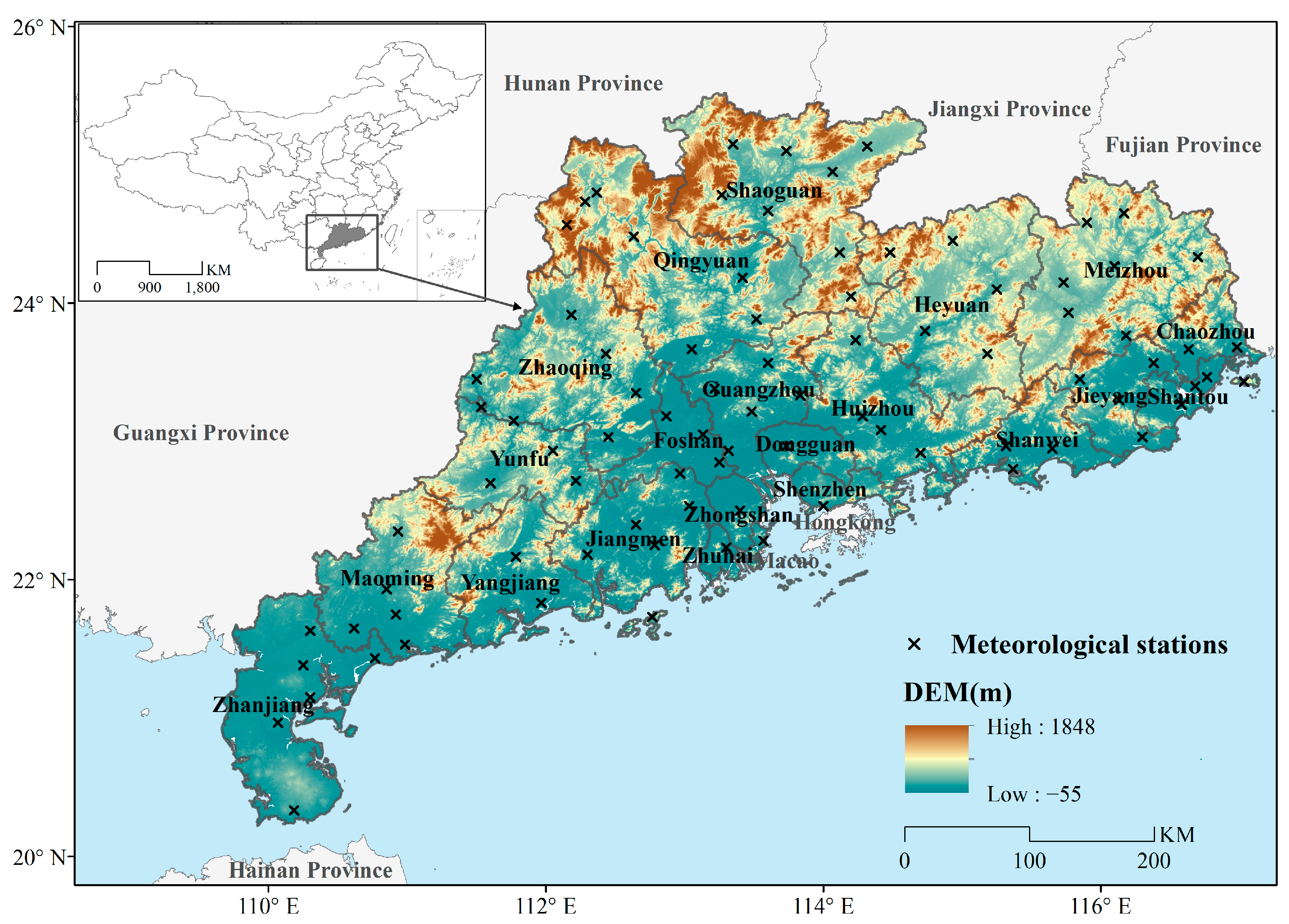
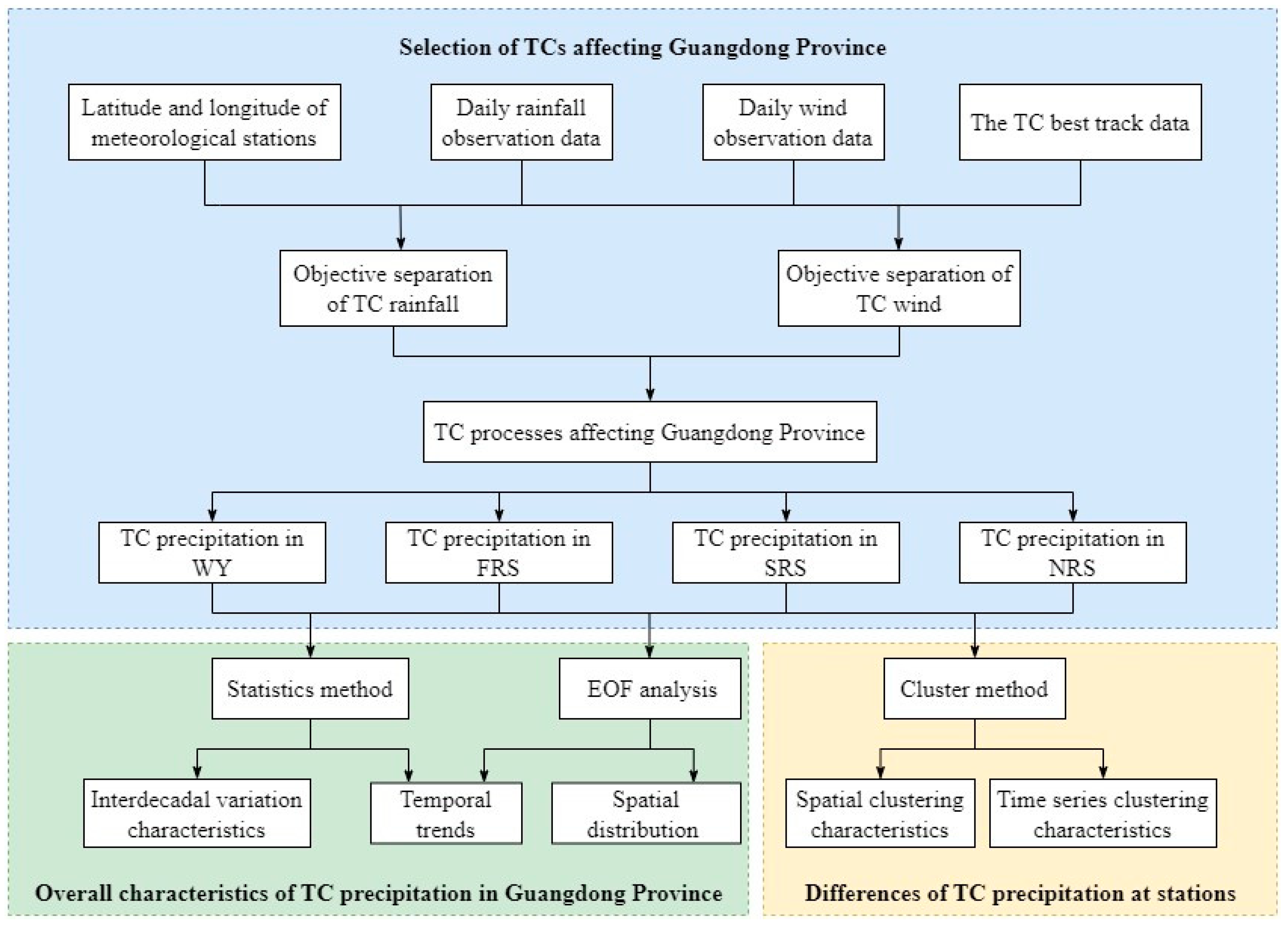
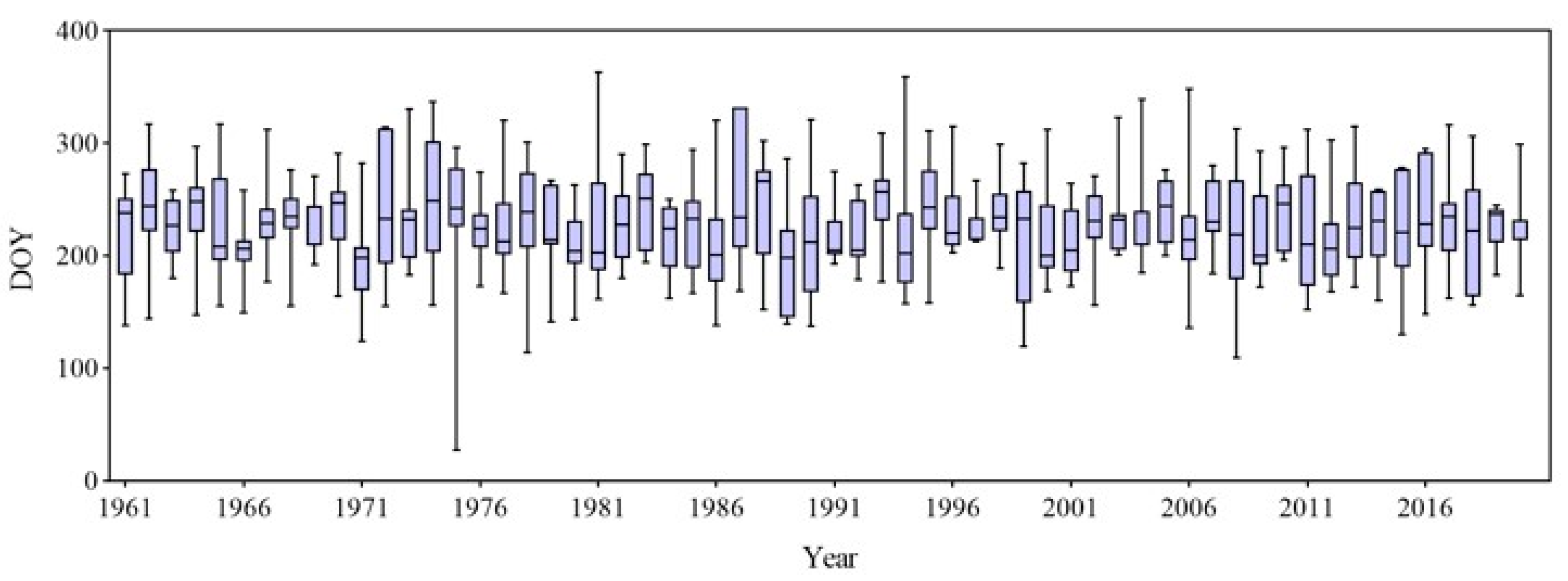
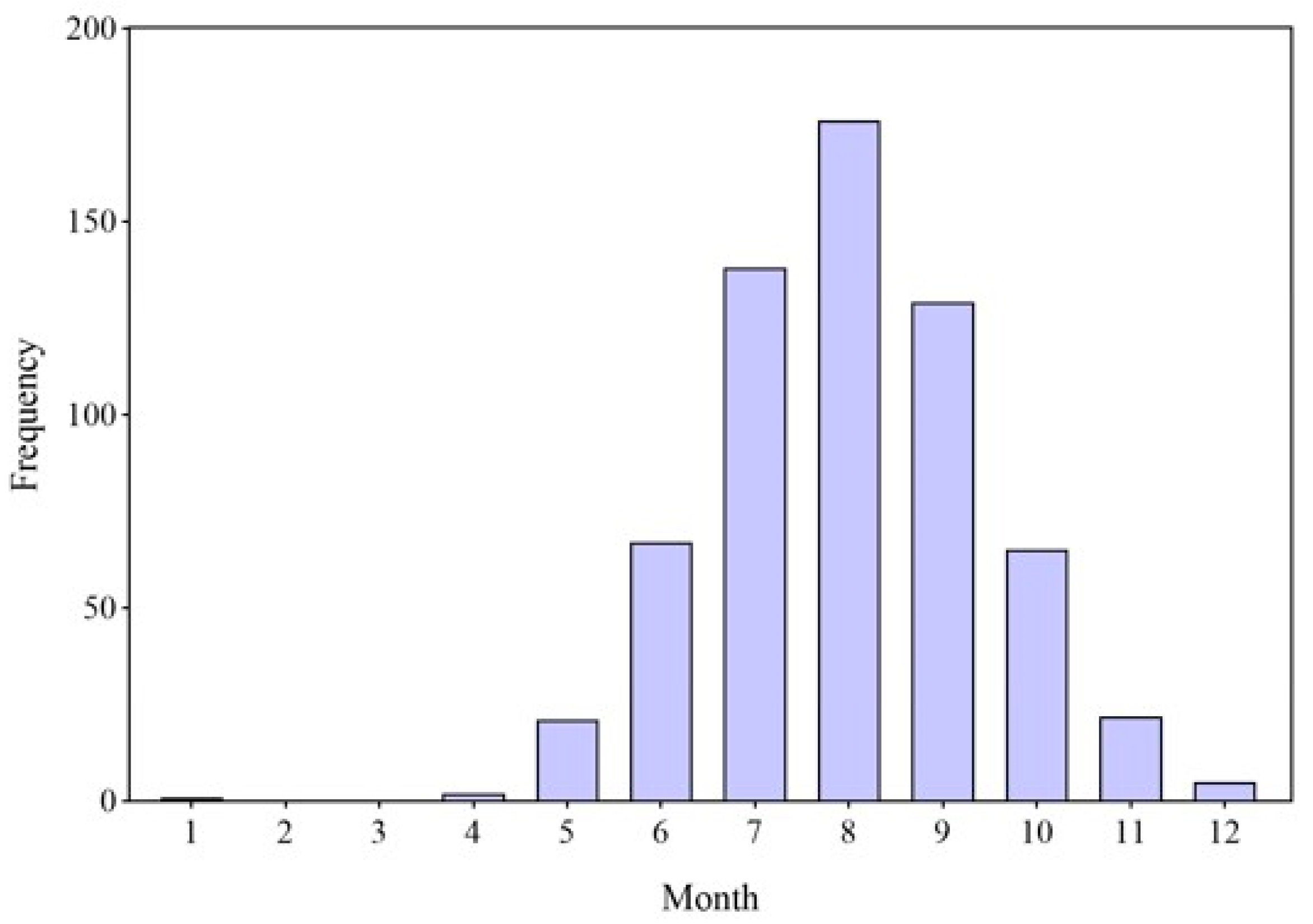
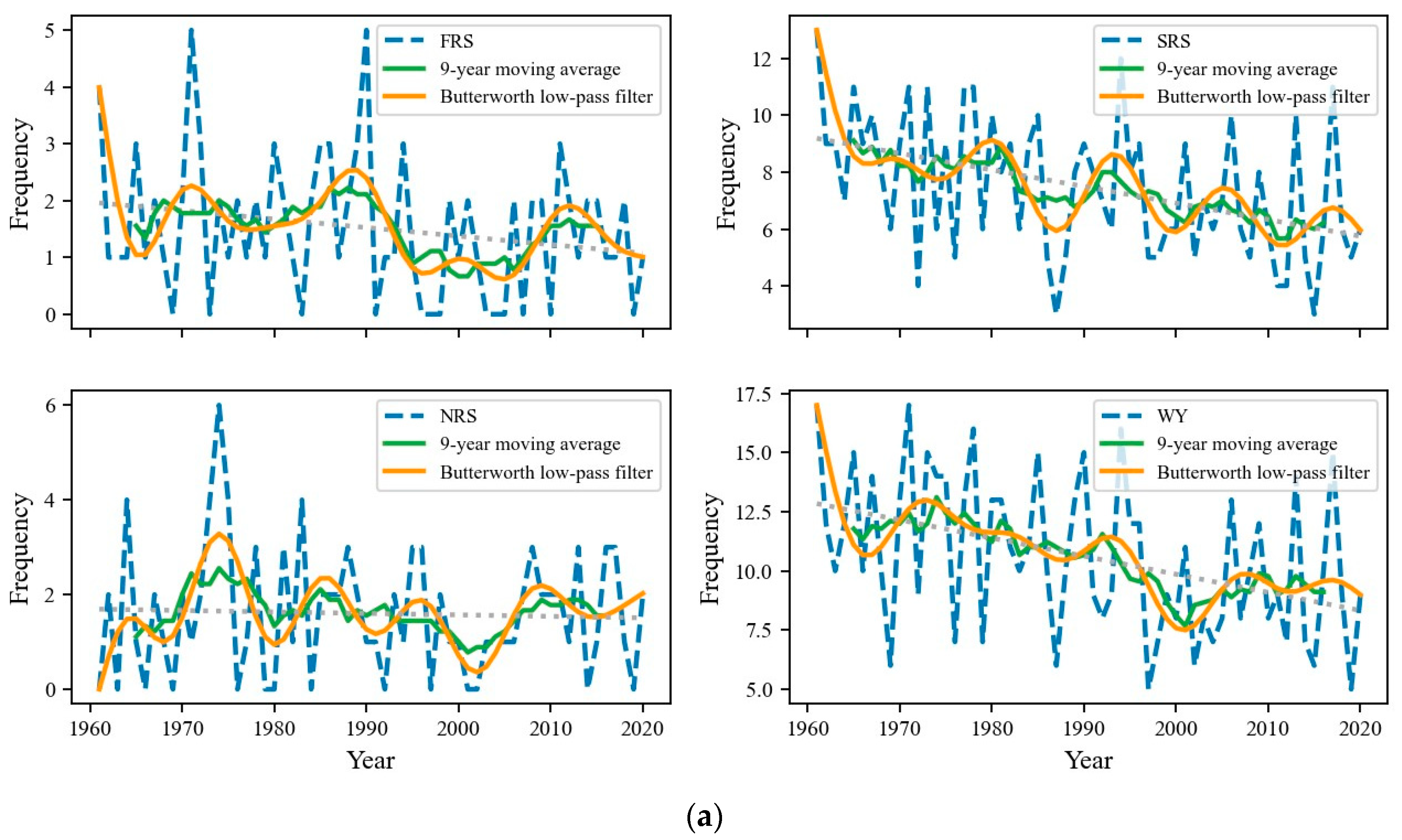
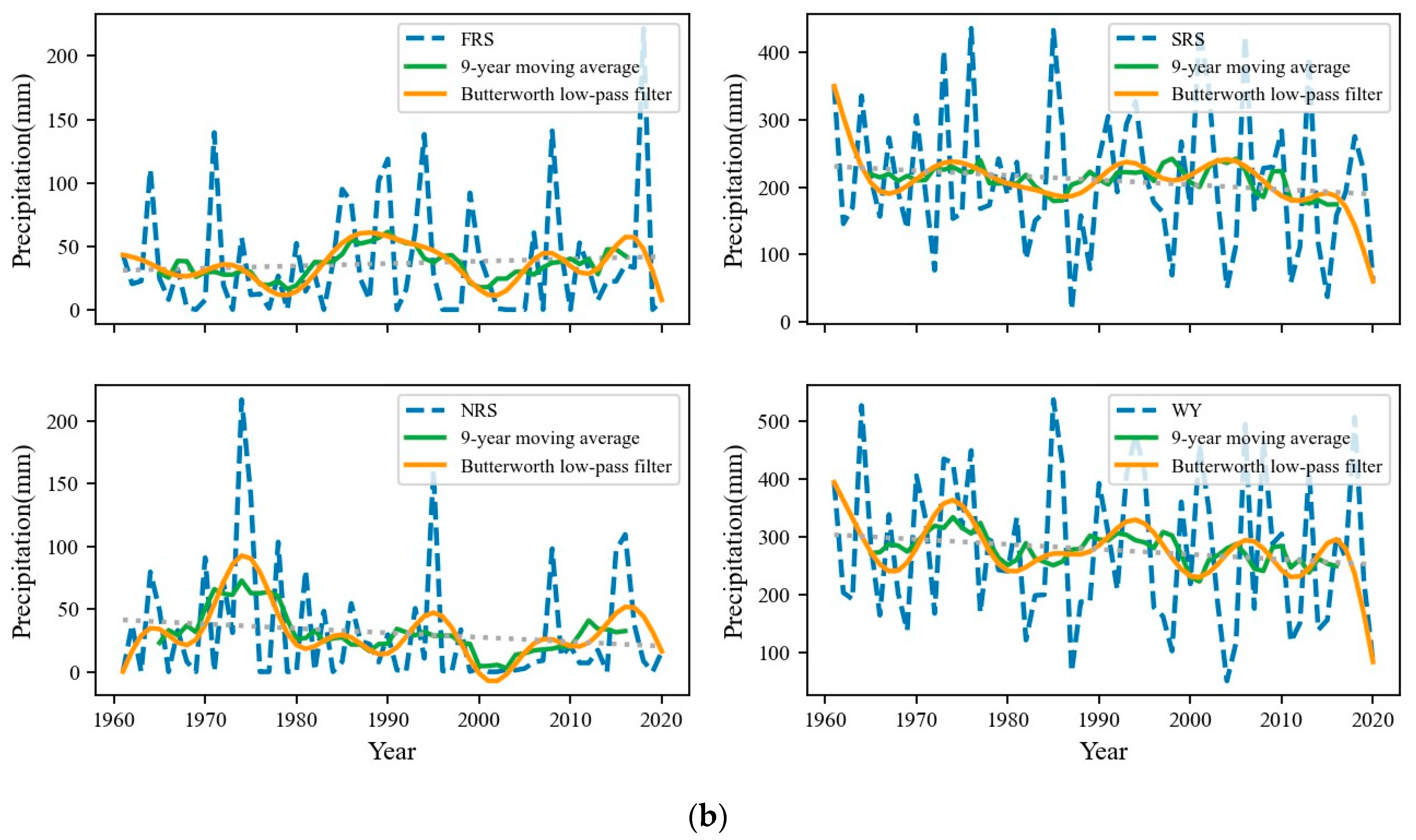
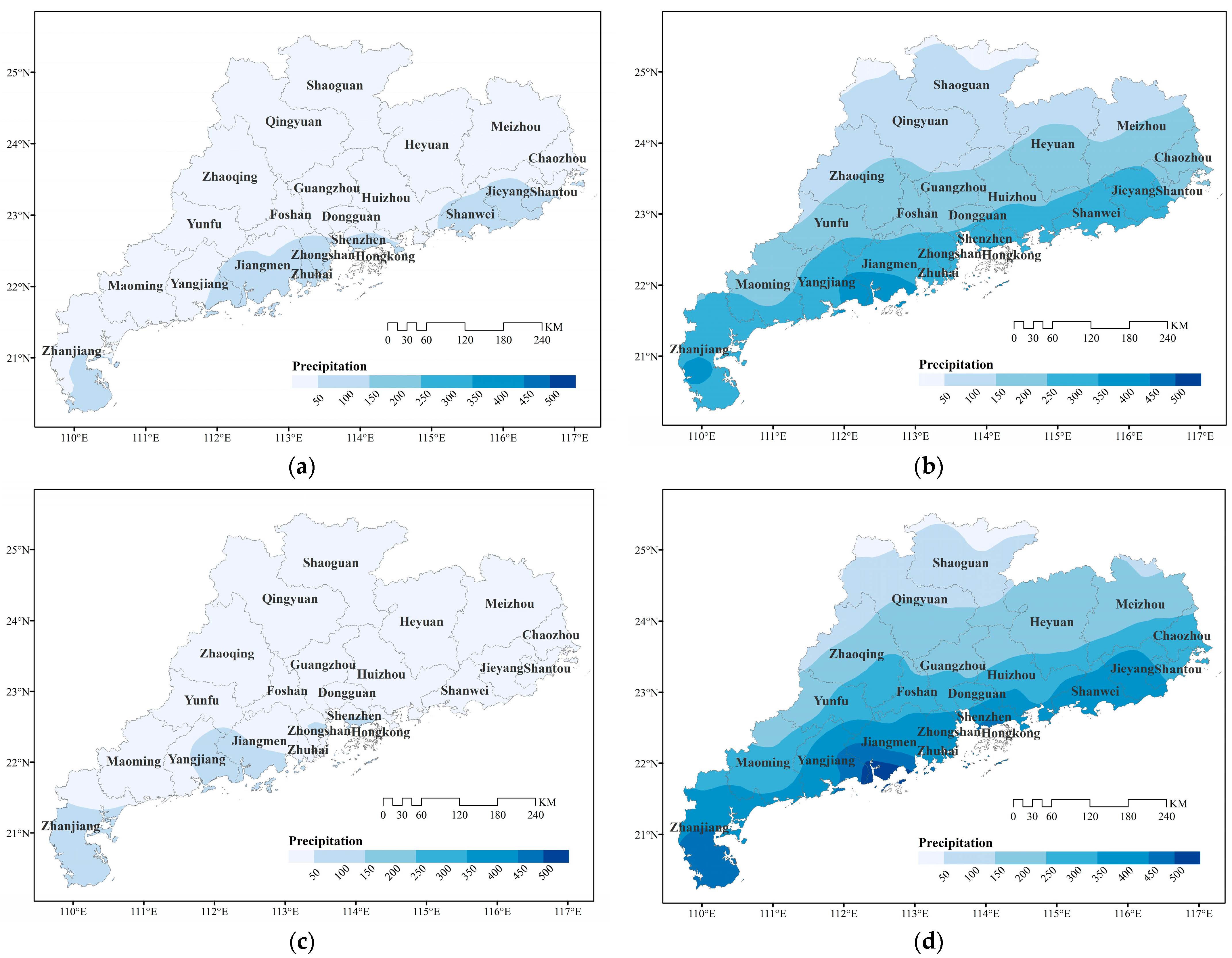
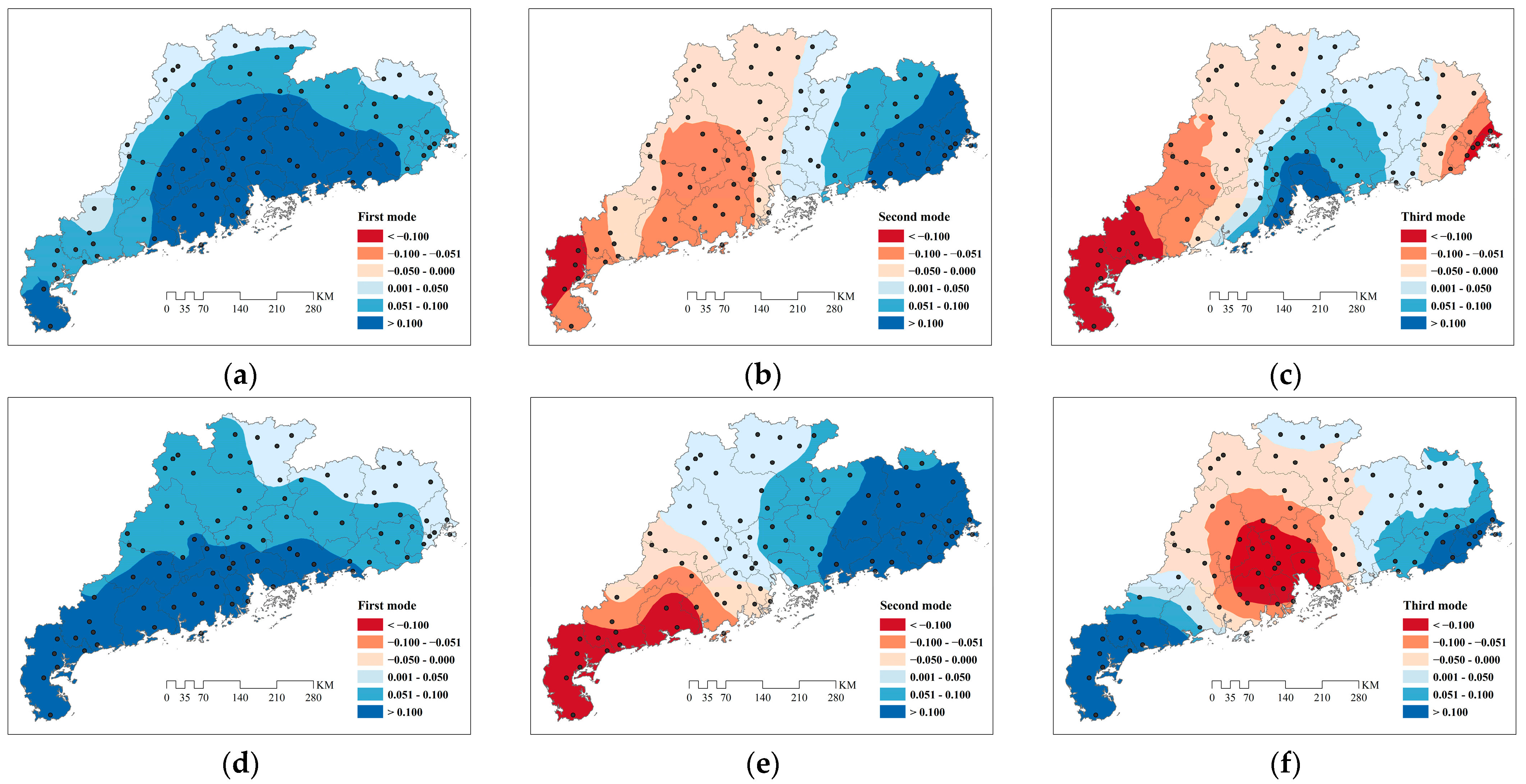
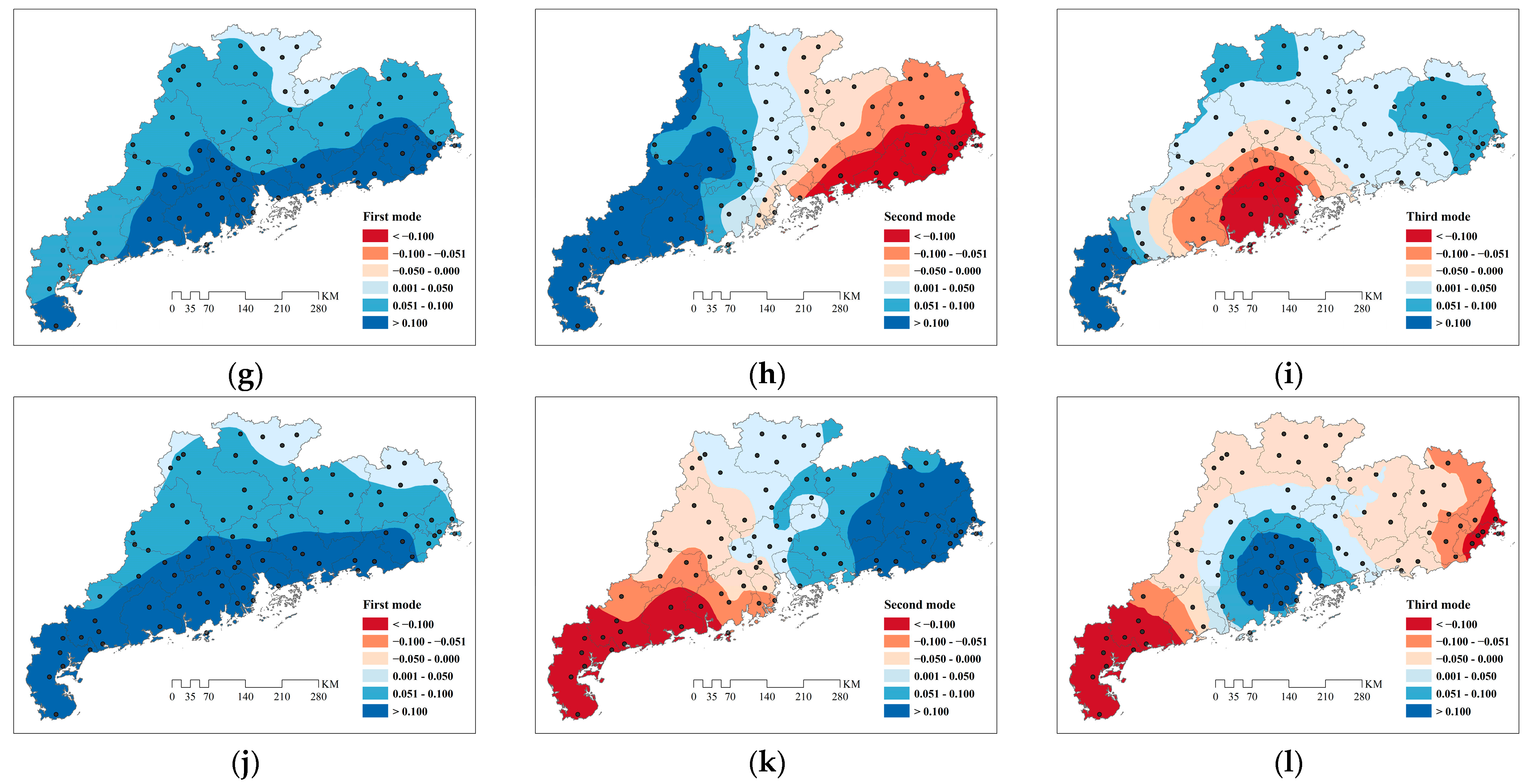
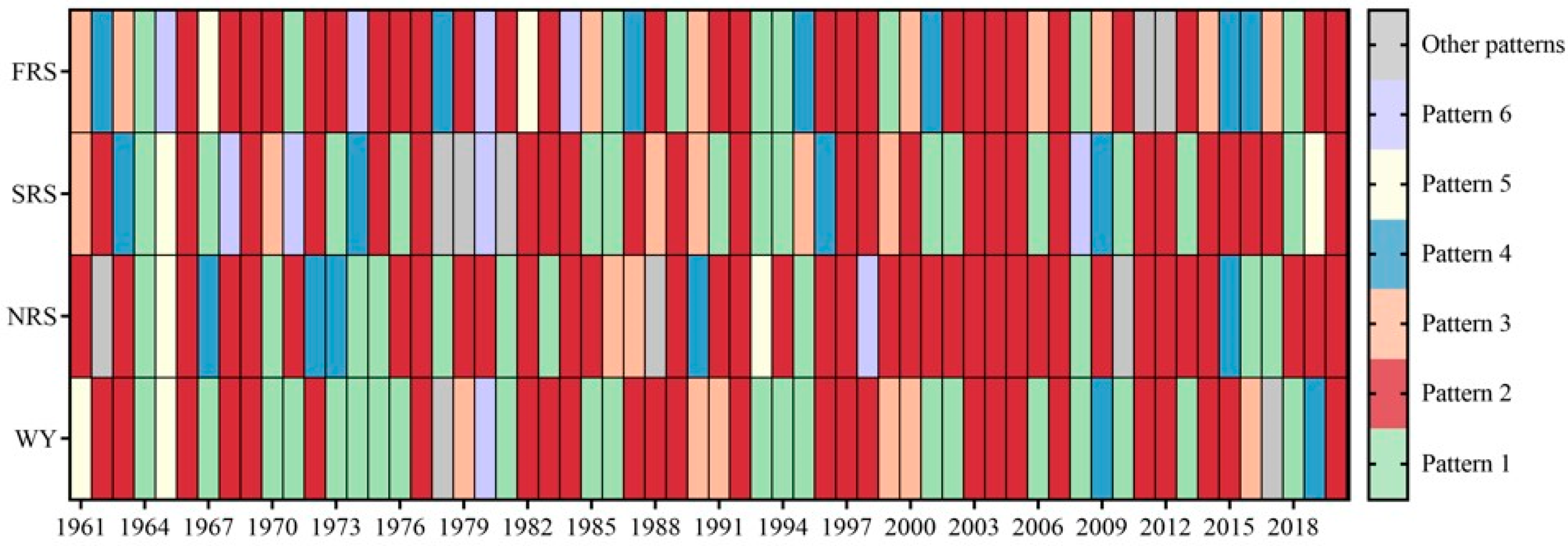
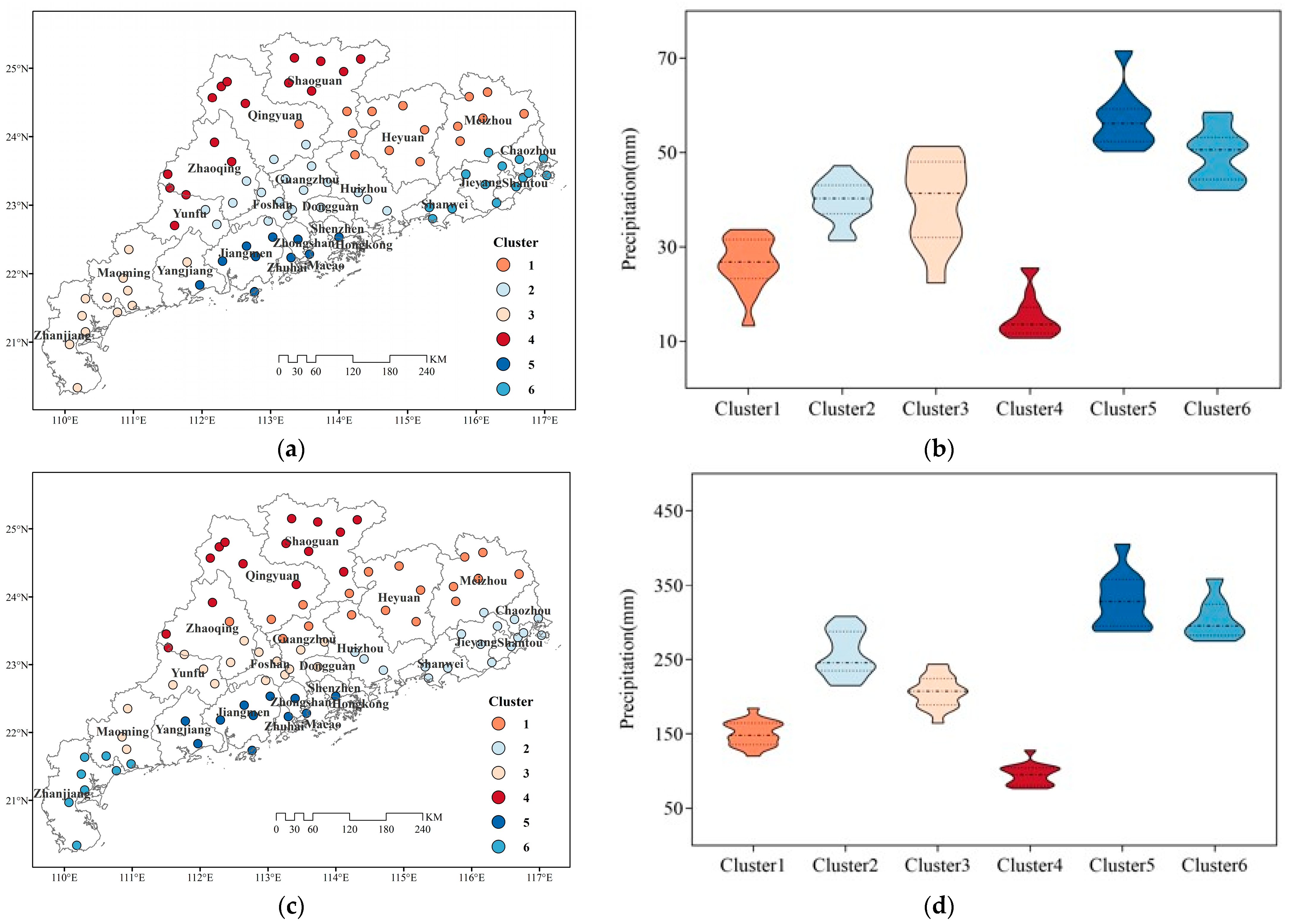

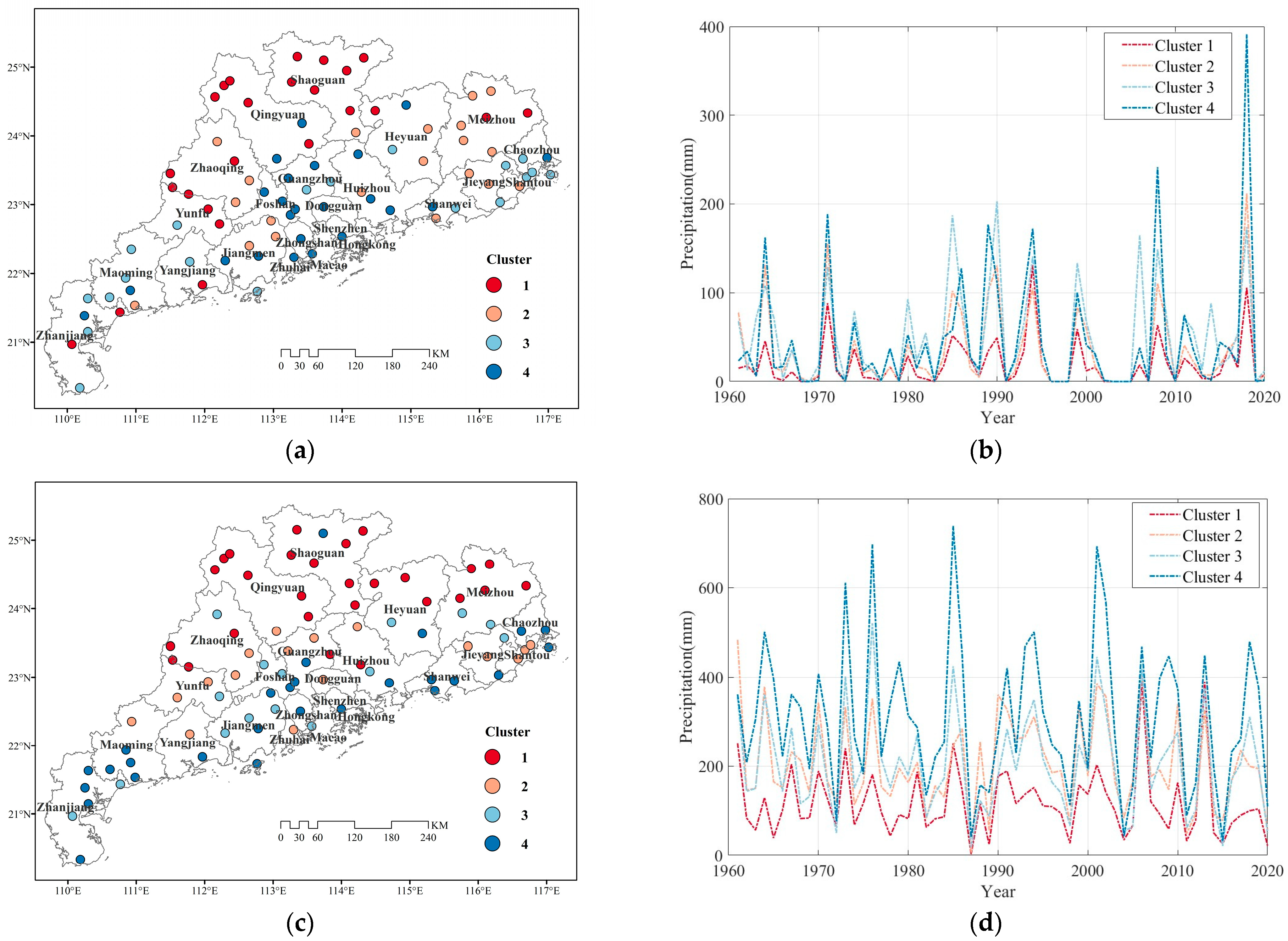
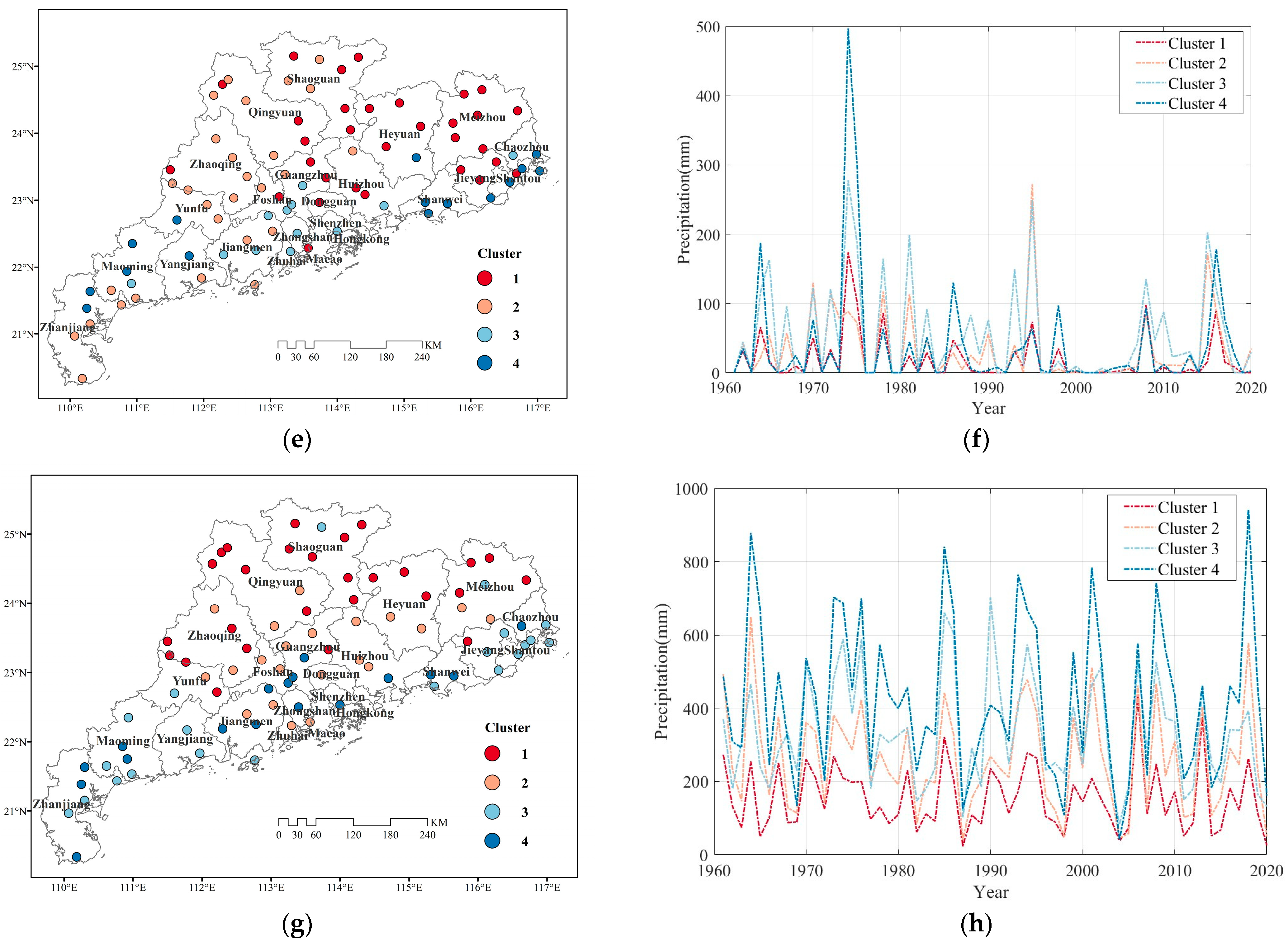
| Maximum Sustained TC Wind Speed (m/s) | Absolute TC Precipitation Distance Control Threshold D0 (km) | Original TC Range Control Threshold D1 (km) | Revised TC Range Control Threshold D1 (km) | |
|---|---|---|---|---|
| TCs far away from GD | <17.2 (tropical depression) | 200 | 600 | 400 |
| 17.2 to 24.4 (tropical storm) | 300 | 800 | 500 | |
| 24.5 to 32.6 (strong tropical storm) | 400 | 1000 | 600 | |
| ≥32.7 (typhoon and above) | 500 | 1100 | 700 | |
| TCs close to GD | <17.2 (tropical depression) | 300 | 800 | 500 |
| ≥17.2 (tropical storm and above) | 500 | 1100 | 700 |
| Maximum Sustained TC Wind Speed (m/s) | Scanning Radius (km) |
|---|---|
| V < 17.2 | 100 |
| V ≥ 17.2 and V < 24.5 | 150 |
| V ≥ 24.5 and V < 32.7 | 200 |
| V ≥ 32.7 and V < 41.5 | 250 |
| V ≥ 41.5 and V < 51.0 | 300 |
| V ≥ 51.0 | 350 |
| Cluster | Max | Min | Mean | Range | k | p | ||
|---|---|---|---|---|---|---|---|---|
| FRS | 1 | 131.03 | 0 | 19.00 | 131.03 | 26.48 | 0.12 | 0.57 |
| 2 | 211.96 | 0 | 34.38 | 211.96 | 45.29 | 0.06 | 0.69 | |
| 3 | 202.93 | 0 | 49.16 | 202.93 | 53.95 | 0.14 | 0.68 | |
| 4 | 391.21 | 0 | 45.83 | 371.21 | 70.31 | 0.40 | 0.50 | |
| SRS | 1 | 390.39 | 2.64 | 117.25 | 387.74 | 76.93 | −0.23 | 0.99 |
| 2 | 483.24 | 6.29 | 206.07 | 476.95 | 103.67 | −0.74 | 0.69 | |
| 3 | 520.24 | 17.29 | 205.75 | 502.95 | 112.37 | −0.79 | 0.51 | |
| 4 | 738.70 | 31.52 | 308.48 | 707.19 | 162.39 | −1.08 | 0.41 | |
| NRS | 1 | 174.05 | 0 | 18.43 | 174.05 | 33.69 | −0.28 | 0.21 |
| 2 | 272.21 | 0 | 31.61 | 272.21 | 50.96 | −0.20 | 0.51 | |
| 3 | 278.43 | 0 | 53.02 | 278.43 | 70.40 | −0.51 | 0.25 | |
| 4 | 497.00 | 0 | 37.55 | 497.00 | 80.93 | −0.67 | 0.23 | |
| WY | 1 | 437.92 | 23.31 | 154.74 | 414.61 | 89.07 | −0.38 | 0.99 |
| 2 | 649.54 | 40.40 | 261.42 | 609.13 | 142.29 | −1.17 | 0.70 | |
| 3 | 701.71 | 81.94 | 333.24 | 619.77 | 148.13 | −0.91 | 0.51 | |
| 4 | 942.14 | 40.86 | 423.98 | 901.27 | 212.44 | −1.23 | 0.41 |
Disclaimer/Publisher’s Note: The statements, opinions and data contained in all publications are solely those of the individual author(s) and contributor(s) and not of MDPI and/or the editor(s). MDPI and/or the editor(s) disclaim responsibility for any injury to people or property resulting from any ideas, methods, instructions or products referred to in the content. |
© 2023 by the authors. Licensee MDPI, Basel, Switzerland. This article is an open access article distributed under the terms and conditions of the Creative Commons Attribution (CC BY) license (https://creativecommons.org/licenses/by/4.0/).
Share and Cite
Zheng, J.; Guo, S.; Zhuo, L.; Wu, H. Spatiotemporal Characteristics of Tropical Cyclone Precipitation in Guangdong Province, China, from 1961 to 2020. Atmosphere 2023, 14, 1367. https://doi.org/10.3390/atmos14091367
Zheng J, Guo S, Zhuo L, Wu H. Spatiotemporal Characteristics of Tropical Cyclone Precipitation in Guangdong Province, China, from 1961 to 2020. Atmosphere. 2023; 14(9):1367. https://doi.org/10.3390/atmos14091367
Chicago/Turabian StyleZheng, Jing, Siying Guo, Li Zhuo, and Hongyu Wu. 2023. "Spatiotemporal Characteristics of Tropical Cyclone Precipitation in Guangdong Province, China, from 1961 to 2020" Atmosphere 14, no. 9: 1367. https://doi.org/10.3390/atmos14091367
APA StyleZheng, J., Guo, S., Zhuo, L., & Wu, H. (2023). Spatiotemporal Characteristics of Tropical Cyclone Precipitation in Guangdong Province, China, from 1961 to 2020. Atmosphere, 14(9), 1367. https://doi.org/10.3390/atmos14091367






